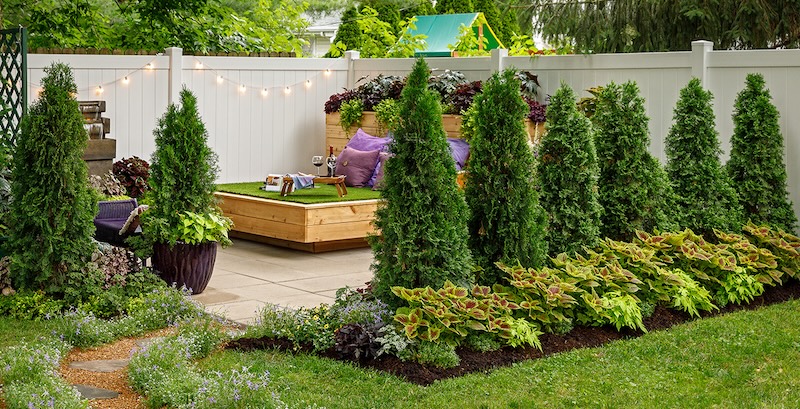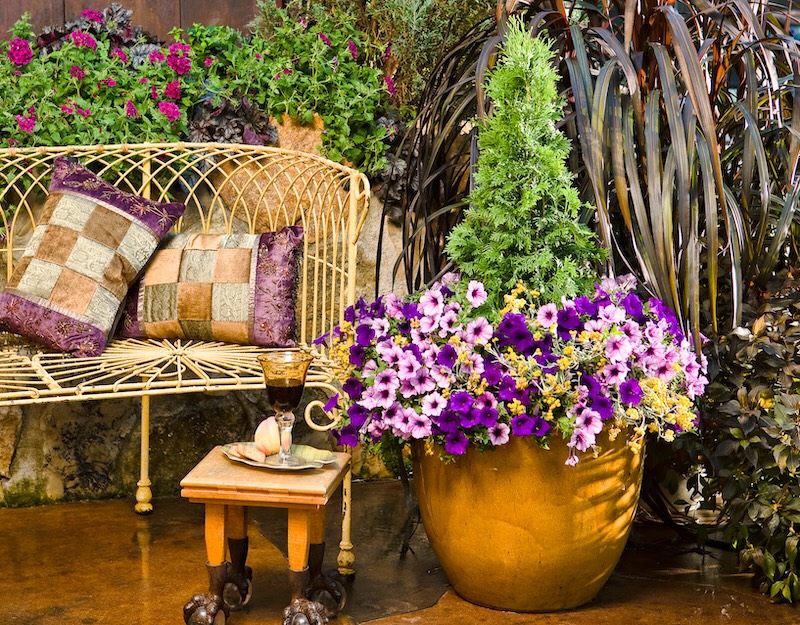Arborvitaes are evergreen conifers in the genus Thuja, native to regions of North America and Asia. These trees and shrubs are one of the most popular landscape plants due to their dense, attractive foliage that stays green year-round. Because of this, arborvitae are excellent plants for privacy screens, windbreaks, and hedges. Arborvitae even lend themselves well to formal plantings and mixed borders.

Arborvitae grow best in neutral to slightly alkaline soils with high fertility and good drainage. These plants should be placed in full to partial sun. Hardy to zones 3-8, arborvitae will need to be watered before and during winter to help prevent desiccation, which causes the leaves to turn brown and die. These trees can grow 10-20 feet tall with a spread of 6-10 feet. Dwarf varieties will only grow to 1-4 feet tall. Since arborvitae are slow-growing and usually columnar in shape, there are many plants that pair well with them in the garden.
Shrubs To Plant With Arborvitae
When choosing shrubs for your garden, look for a variety of textures, heights, and forms for layers of interest. Grow arborvitae with other evergreen trees and shrubs, such as boxwood, for year-round interest in your garden. Adding small deciduous trees, such as redbud and dogwood, will add a taller, branching architecture to your landscape. The feathery needles of arborvitae complement the large, heart-shaped leaves of redbud, and both redbud and dogwood produce stunning flowers in spring. Finally, consider flowering shrubs such as hydrangea for partly shady sites. These long-blooming shrubs will provide pops of color next to arborvitae.
Perennials To Plant With Arborvitae
Arborvitae makes a perfect evergreen backdrop for perennial plants. Arborvitae can be grown with many perennials that thrive in full to partial shade. Consider planting arborvitae with perennial vines, like clematis, to add color. If your arborvitae casts shade during the day, opt for shade-loving plants such as hellebores, hostas, ferns, and Solomon’s seal (Polygonatum). Groundcovers are another excellent companion for arborvitae, as their sprawling, horizontal, and low growth contrasts nicely with arborvitae’s taller, vertical form. Wild ginger (Asarum) and coral bells (Heuchera) are two groundcovers that pair well with arborvitae.

Annuals To Plant With Arborvitae
Companion planting with annuals allows you to try out new design combinations every year. Choose annuals that prefer fertile, well-drained soil and can grow in full or partial sun. Annuals such as geraniums and begonias can be grown in brighter locations and will provide vibrant flowers and colorful, interesting foliage. For locations that are shaded by the arborvitae, consider growing shade-tolerant annuals such as impatiens for season-long blooms.
Best Companion Plants For Arborvitae in Containers
Arborvitae makes an excellent focal point in mixed containers, especially when growing dwarf cultivars. Plant your arborvitae in the center of a large pot. Fill in the space around it with foliage plants such as coleus, bergenia, and coral bells for a variety of texture and color. Add trailing plants, such as creeping Jenny (lysimachia), for a full, lush look. Grow your arborvitae and companion plants in a well-drained potting mix with perlite and slow-release fertilizer. Let the soil dry out in between watering.

Plants Not To Grow With Arborvitae
Although arborvitae can be grown with many plants, there are some that should be avoided. Since arborvitae prefers neutral to slightly alkaline soil, avoid growing it with plants that need more acidic soil. Doing so can result in nutrient deficiencies, yellowing of leaves, and decline of the plants. For example, ericaceous plants such as rhododendrons, blueberries, wintergreen, and mountain laurel should not be planted with arborvitae, as they prefer acidic soils.
Additionally, do not plant arborvitae in wet soils or with plants that grow best in wet soil, since arborvitae needs well-drained soil to survive. When grown in wet conditions, arborvitae is prone to conditions such as root rot. Growing wetland plants with arborvitae, such as cardinal flower (Lobelia cardinalis), will result in poor plant health.
Best Plants To Grow With Arborvitae
The best plants to grow with arborvitae are shrubs, perennials, and annuals that prefer full to partial sun and thrive in rich, well-drained soil. Growing arborvitae with flowering shrubs and small trees such as hydrangeas, redbud, and dogwood will ensure your garden has plenty of color and interesting form. Evergreen shrubs like boxwood will work well with arborvitae, as they will add color to your landscape even through the winter.
Perennials and annuals, like hellebores, hostas, Solomon’s seal, begonias, and geraniums can be planted in front of and around arborvitae, since it acts as a neutral backdrop. Grow arborvitae as a thriller in containers with filler plants such as coral bells and bergenia and spiller plants like creeping Jenny.
 |
Lauren Youngcourt - Published 11-22-2023 |
